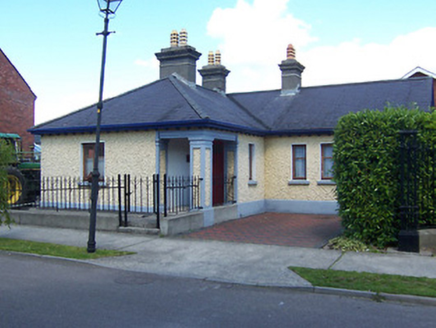Survey Data
Reg No
15310160
Rating
Regional
Categories of Special Interest
Architectural, Artistic, Social
Original Use
Gate lodge
In Use As
House
Date
1880 - 1900
Coordinates
243724, 253203
Date Recorded
07/07/2004
Date Updated
--/--/--
Description
Detached single-storey gate lodge on L-shaped plan, built c.1890. Originally built to serve the Presentation Convent (15310158) to the north but now in use as a private house. Hipped and pitched natural slate roof with overhanging eaves with timber brackets and having moulded rendered chimneystacks with terracotta pots over. Roughcast rendered walls over smooth rendered plinth. Square-headed window openings with rendered reveals and replacement windows. Open porch to the south corner of advanced bay to the west having a rendered pier to the front with moulded cornice over and with matching moulded cornice to adjacent sections of main body of building. Recessed square-headed doorway with timber panelled door having a plain overlight. Rendered plinth wall with decorative wrought-iron railings bounds house to the northwest side. Located adjacent to the north of the main entrance gates serving the Presentation Convent, comprising a low rendered plinth wall on crescent-shaped plan having decorative wrought-iron railings over and open-work iron piers on square-plan to the corners. Set back from road in own grounds to the southeast side of Bishop’s Gate Street.
Appraisal
A modest but well-detailed gate lodge of late nineteenth-century appearance, which retains much of its early character and form. The good quality chimneystacks, the overhanging bracketed eaves and the applied rendered detailing to the open porch lends this building a certain architectural character. The replacement fittings to the window openings fail to detract from its visual appeal. This building was originally associated with the Presentation Convent (15310158) and forms part of an interesting group of structures associated with this ecclesiastical complex, which has played an important role in the social history of Mullingar. The imposing and well-detailed wrought-iron screen railings and open-work gate posts to the south adds substantially to this composition, adding interest to the streetscape to the east end of Bishop’s Gate Street.

